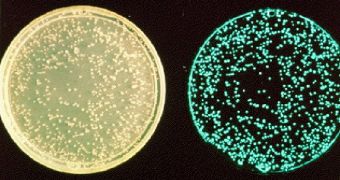In a more unusual study, researchers have demonstrated that they can condition artificially engineered bacterial cells to produce amazing light shows under a microscope. Their challenge did not lay as much in creating the cells themselves, as it did in making them fluoresce simultaneously, and in various types of patterns. The conditioning was done by sending specific types of signals to the bacteria, basically telling them to turn the production of a certain fluorescent protein on or off. The genetic clocks on the microorganisms were also tinkered with, in order to produce the light-show effect, BBC News reports.
Beyond the interest that the bizarre display of synchrony produced, the team behind the study says that its work may actually have some very significant applications, not the least of which being the ability to create drugs that can gradually release medication on command. Additionally, biological sensors may also use some of the same basic processes employed in creating this display of light for their own construction phases. Details of the work appear in the latest advanced online issue of the renowned scientific journal Nature.
The study was carried out by US researchers at the University of California in San Diego (UCSD). The team, led by expert Dr. Jeff Hasty featured the same members that managed to demonstrate “flashing cells” less than a year ago. The current work was actually an improvement on the previous study, with many more new features added to the programming of the cells. The team reveals that, in addition to making the bacteria shine in various patterns, it also enabled the microorganisms to talk to each other while doing so. The activity patterns therefore remained synchronized even as the bacteria developed a large colony.
“If you want a sensor – if you want to use the rate at which the cells switch on and off to signal something about the environment, you need a synchronized signal,” Hasty explained. “Part of the whole excitement of synthetic biology was to make a branch of molecular biology into an engineering discipline. The aim is to use computational tools to design biological circuits from scratch. We're not quite there yet, but we can already design some of these [simple] systems,” the expert added.
The recent study is “a dramatic achievement. The real breakthrough [will be] when we can do this in mammalian cells, and this has laid the foundation for that. Oscillators could eventually be designed to produce insulin every six hours [in diabetic patients]. When doctors tell you to take this pill three times a day, that's this is nothing more than an oscillation – a dose at a frequency. An engineered oscillator could do this automatically,” Swiss scientist Martin Fussenegger, who is a professor at the ETH Zurich, a science and technology university, added. He was not involved in the research.

 14 DAY TRIAL //
14 DAY TRIAL //